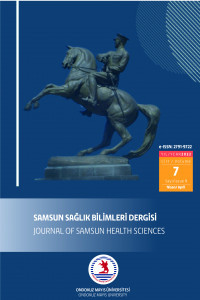WOLF HİRSCHHORN SENDROMUNDA ODYOLOJİK BULGULAR: OLGU SUNUMU
Wolf-Hirschhorn sendromu (WHS), klinik olarak doğum öncesi ve doğum sonrası büyüme eksikliği, ayırt edici kraniyofasiyal özellikler, mental retardasyon ve nöbetlerle tanımlanan bitişik bir gen bozukluğudur. Hastalığa 4. kromozomun kısa kolunun distal kısmında oluşan kısmi kayıp neden olur. Literatürde WHS'li bireylerde işitme kaybı bildirilmiş olmasına rağmen, sensörinöral işitme kaybı nadirdir. Bu makalede sensörinöral işitme kaybı mevcut olan WHS’li hastanın işitme kaybı ve işitme cihazı ile rehabilitasyonu hakkında bilgi vermek amaçlanmıştır.
Anahtar Kelimeler:
Wolf-Hirschhorn sendromu, sensörinöral işitme kaybı, işitme cihazı, İşitsel rehabilitasyon
Audiological Findings in Wolf Hirschhorn Syndrome: A Case Report
Wolf-Hirschhorn syndrome (WHS) is a contiguous gene disorder clinically characterized by prenatal and postnatal growth deficiency, distinctive craniofacial features, mental retardation, and seizures. The disease is caused by partial loss of the distal part of the short arm of chromosome 4. Although hearing loss has been reported in individuals with WHS in the literature, sensorineural hearing loss is rare. In this article, it is aimed to give information about hearing loss and rehabilitation with a hearing aid in a patient with WHS who has sensorineural hearing loss.
Keywords:
Wolf-Hirschhorn syndrome, Sensorineural hearing loss, Hearing aid, Auditory rehabilitation,
___
- Battaglia, A., Carey, J. C., & South, S. T. (2015). Wolf–Hirschhorn syndrome: A review and update. Paper presented at the American Journal of Medical Genetics Part C: Seminars in Medical Genetics.
- Battaglia, A., Filippi, T., & Carey, J. C. (2008). Update on the clinical features and natural history of Wolf–Hirschhorn (4p‐) syndrome: Experience with 87 patients and recommendations for routine health supervision. Paper presented at the American Journal of Medical Genetics Part C: Seminars in Medical Genetics.
- Battaglia, A., Filippi, T., South, S. T., & Carey, J. C. (2009). Spectrum of epilepsy and electroencephalogram patterns in Wolf–Hirschhorn syndrome: experience with 87 patients. Developmental Medicine & Child Neurology, 51(5), 373-380.
- Flipsen-ten Berg, K., Van Hasselt, P. M., Eleveld, M. J., van der Wijst, S. E., Hol, F. A., de Vroede, M. A., . . . Poot, M. (2007). Unmasking of a hemizygous WFS1 gene mutation by a chromosome 4p deletion of 8.3 Mb in a patient with Wolf–Hirschhorn syndrome. European Journal of Human Genetics, 15(11), 1132-1138.
- Hereditary Hearing Loss Homepage. (2022). Retrieved from https://hereditaryhearingloss.org/
- Lesperance, M. M., Grundfast, K. M., & Rosenbaum, K. N. (1998). Otologic manifestations of Wolf-Hirschhorn syndrome. Archives of Otolaryngology–Head & Neck Surgery, 124(2), 193-196.
- Mekkawy, M. K., Kamel, A. K., Thomas, M. M., Ashaat, E. A., Zaki, M. S., Eid, O. M., . . . ElAwady, H. (2021). Clinical and genetic characterization of ten Egyptian patients with Wolf–Hirschhorn syndrome and review of literature. Molecular Genetics & Genomic Medicine, 9(2), e1546.
- Morton, C. C., & Nance, W. E. (2006). Newborn hearing screening—a silent revolution. New England Journal of Medicine, 354(20), 2151-2164.
- Sakuma, N., Moteki, H., Takahashi, M., Nishio, S.-y., Arai, Y., Yamashita, Y., . . . Usami, S.-i. (2016). An effective screening strategy for deafness in combination with a next-generation sequencing platform: a consecutive analysis. Journal of human genetics, 61(3), 253-261.
- Ulualp, S. O., Wright, C. G., Pawlowski, K. S., & Roland, P. S. (2004). Histopathological Basis of Hearing Impairment in Wolf‐Hirschhorn Syndrome. The Laryngoscope, 114(8), 1426-1430.
- Xiang, Y. B., Xu, C. Y., Xu, Y. Z., Li, H. Z., Zhou, L. L., Xu, X. Q., . . . Tang, S. H. (2020). Next‐generation sequencing identifies rare pathogenic and novel candidate variants in a cohort of Chinese patients with syndromic or nonsyndromic hearing loss. Molecular Genetics & Genomic Medicine, 8(12), e1539.
- Yönü, İ. K. G. (2012). Türkiye'deki Görünümü. Turkiye Klinikleri J ENT-Special Topics, 5(2), 15-20.
- Yayın Aralığı: Yılda 3 Sayı
- Başlangıç: 2021
- Yayıncı: Ondokuz Mayıs Üniversitesi
Sayıdaki Diğer Makaleler
EBEVEYNLERİN AĞRISI OLAN ÇOCUĞA YAKLAŞIMLARI
Emine GÜDEK SEFEROĞLU, Nuriye DEĞİRMEN, Ayşe GÜROL
HEMŞİRELİK ÖĞRENCİLERİNİN İZOLASYON ÖNLEMLERİNE UYUM, TUTUM VE DAVRANIŞLARININ BELİRLENMESİ
Serap ÜNSAR, İrem YILDIZ ÇİLENGİROĞLU, Gülcan MEŞHUR, Esra DUMAN, Nilay ÖZLEMİŞ
BİLİŞSEL İŞLEVLER ÜZERİNE YAPILAN ÇALIŞMALARDA GELİŞİMSEL YÖNELİMİN BELİRLENMESİ
VEJETARYEN DİYETLERDE BESİN TÜKETİMLERİ VE BEDEN KÜTLE İNDEKSİ FARKLILIKLARI
Fatima ALHAMROSH, Ayman MUSTAFA, Bahtınur TAŞCI
Egzersiz Yapmanın Kadın Öz Güvenine Etkisi
Seçil HÜR, Ayça ŞOLT, Gökhan KIRCA
OECD ÜLKELERİNDE COVİD-19 PANDEMİSİNİN ÇOK KRİTERLİ KARAR VERME YÖNTEMLERİYLE DEĞERLENDİRİLMESİ
EV KAZALARINDA VE DÜŞMELERDE YAŞLI BİREYLERE YÖNELİK HEMŞİRELİK BAKIMI
